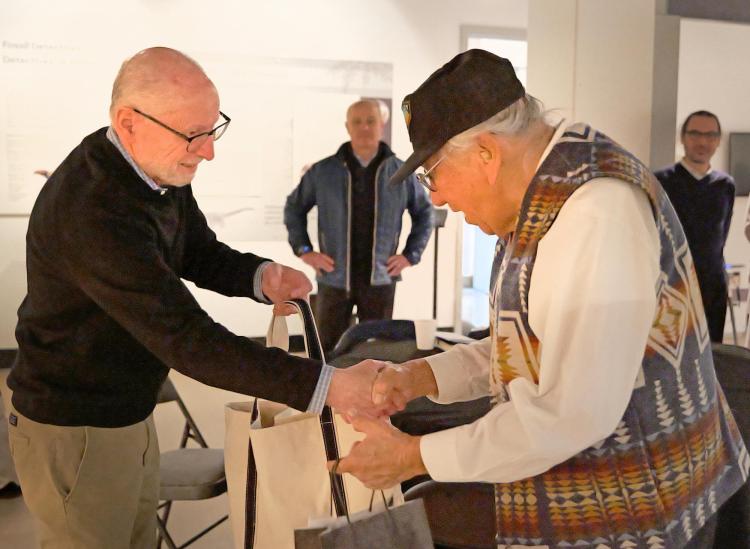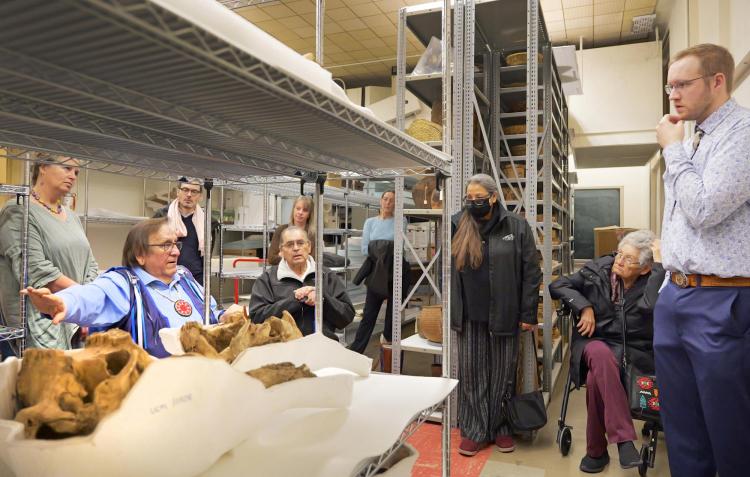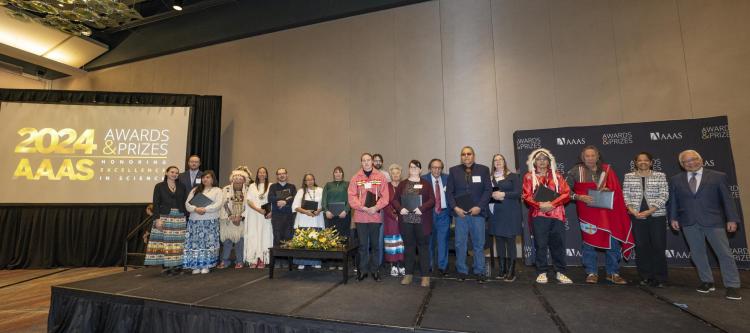Lakota Elders Forge Historic Partnership with University of Colorado Boulder Through Landmark Visit
This week, a delegation of elders from the Lakota Nation made the nearly 6-hour drive to Boulder, Colorado, from the Pine Ridge Reservation and the Black HIlls of South Dakota. They included Chief Joseph American Horse, Chief Harold Left Heron and nearly a dozen others.
The group met with Provost Russell Moore, Vice Chancellor Massimo Ruzzene and other members of the CU Boulder community in the University of Colorado Museum of Natural History’s Paleontology Hall on Thursday. It was a long trip, but, as elder Milo Yellow Hair told the audience, the Lakota have a rich history in Colorado.
“We’ve been here a long time,” Yellow Hair said, standing alongside fossils of ancient spiral-shelled creatures called ammonites and a petrified tree. “We know [these mountains] because they are the backbone of Mother Earth.”
Yellow Hair and his fellow elders, representatives of an organization called the Global Institute for Traditional Sciences (Taku Škaŋ Škaŋ Wasakliyapi), had come to Boulder to forge stronger relationships with researchers on campus—exploring how Indigenous knowledge and sciences could expand and strengthen existing university science opportunities.
As Assistant Professor William Taylor noted, collaborations between these groups in Western academia have historically been “short, hurried, chaotic and focused on the wrong kind of goals.”
“We’re here together because we’re trying to change that,” said Taylor, curator of archaeology at the CU Museum.
CU Boulder Provost Russell Moore presents gifts to Chief Joseph American Horse. (Credit: Casey Cass/CU Boulder)
Lakota elders share their insights with Assistant Professor William Taylor amid the bison collection at the CU Museum of Natural History. (Credit: Casey Cass/CU Boulder)
Several co-authors of a 2023 study reimagining the history of horses and Indigenous people in the American West accept the Newcomb Cleveland Prize at an award ceremony Friday, Feb. 16. (Credit: Robb Cohen Photography & Video)
To build those ties, the visit included an exchange of gifts, an important facet of Lakota ceremonies. Elders received bags filled with, among other things, pouches handmade by Taylor’s mother with the silhouette of a bison against a starry sky. Delegation members gave Moore, Taylor and others glass statues woven through with bright reds, greens and blues that represented life.
“When you see the sun shine through, then you can think of us and the wonderful work that we can continue to do together,” said Yvette Running Horse Collin, a member of the Lakota Nation and leader at the global institute.
It was a sentiment that Moore was happy to share.
Such collaboration “gives us a sense of possibilities for the future and how we can combine traditional knowledge with Western science to unlock great truths,” Moore told the delegation. “We look forward to extending these partnerships in areas ranging from law to linguistics and climate science, to name a few.”
Journey on horseback
Taylor has seen the value of those kinds of partnerships first-hand.
On Friday, Feb. 16, he and the Lakota elders made a second stop in Colorado—this time, to the annual meeting of the American Association for the Advancement of Science (AAAS) in Denver. They were joined by geneticist Ludovic Orlando from the Centre for Anthropobiology of Toulouse in France and other partners at universities across the world.
The group accepted the association’s Newcomb Cleveland Prize, an annual award given to the most outstanding paper published in the journal “Science.”
For the research, Taylor, Orlando and Running Horse Collin teamed up with researchers from 15 countries and several Native American groups, including the Lakota, Pawnee and Comanche nations. They addressed a question that is near and dear to the hearts of Yellow Hair and his fellow elders: the history of horses and Indigenous Peoples in the American West.
Drawing on archaeozoology, DNA evidence, Indigenous knowledge and more, the team showed that horses had earlier roots across much of North America than European accounts suggested.
“Walking the earth as Lakota is to protect, sustain and advocate for all life,” said American Horse, an Indigenous scientist, knowledge keeper and co-author of the award-winning study. “This global collaboration, and those to come, are what is necessary for ourselves and all peoples to protect their traditional lands, relations and lifeways for the sustainability of Grandmother Earth and all life. The time is upon us.”
The researchers donated the $25,000 in prize money to create a new endowment at CU Boulder. The endowment is named in memoriam for the late Sam High Crane, study co-author and elder, Knowledge Keeper and cultural educator for the Sicangu Lakota People. It will help support research and training for Indigenous students in archaeology, archaeogenetics and the museum world.
Paying respect to bison
As part of the visit to Boulder on Thursday, Taylor brought the elders to a collections room tucked into the back of the museum. There, the men and women walked past shelves stacked with thousands of bones belonging to about 200 bison. Scientists had uncovered these 11,000-year-old remains in the mid-20th century in an arroyo near Kit Carson, Colorado.
“What we’d like to do is rethink how we’re caring for these,” Taylor told the group.
American Horse explained that bison, like humans or horses, “have spirits.”
“One thing you’ve got to remember is it’s important to protect these,” he said.
The delegation offered some early ideas: The museum could, for example, store the bison skulls and other bones along with sprigs of sage, a sign of respect.
Left Heron sang and spoke a blessing in the Lakota language over the remains. Yellow Hair strode across the room, whipping a bundle of feathers around the assembled guests.
It was a powerful moment for Elena Lompe. She’s a master’s student in CU Boulder’s Museum and Field Studies program whose family comes from the Oglala band of the Lakota people.
“Coming from a Native background and a museum background, I think it’s really important that we start to recognize the agency and animacy of objects—recognizing that they have power and taking care of them in more than just a Western way,” Lompe said. “Just hearing my language and creation stories in the collection space is really emotional.”
Past and future
Nancy Stevens, director of the CU Museum, knows it won’t be the last time the Lakota language rings out through the museum.
In Paleontology Hall, she called attention to the displays of ancient animals:
“We are deeply honored to spend time together with you all today, in conversation and connection, immersed in the deep past of this place and with an eye to the future of what we can become.”
Running Horse Collin embraced the sentiment and reminded the audience that Lakota take those kinds of promises seriously.
“For us, partnerships are not just moments,” she said. “They are for the long term.”




